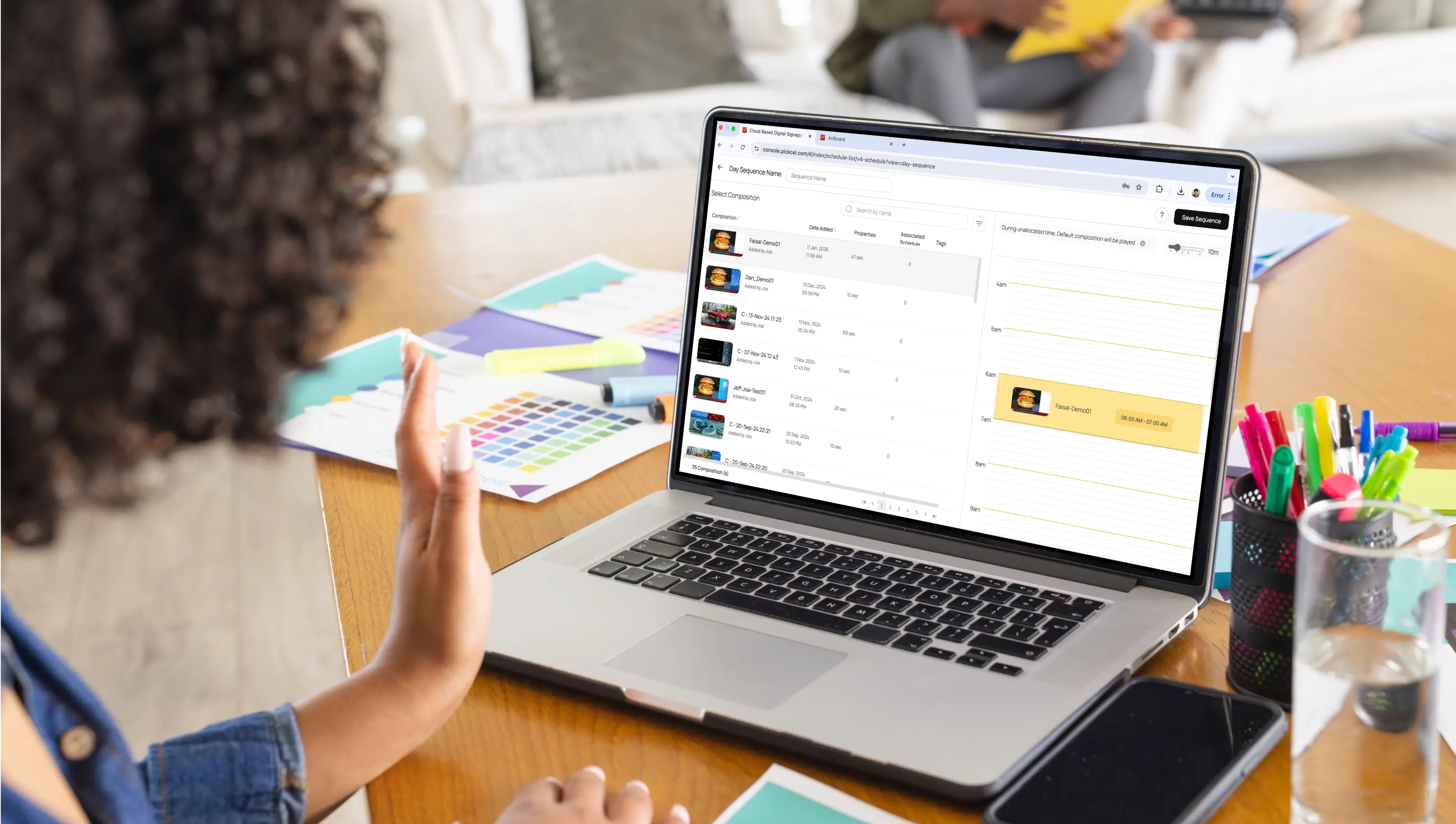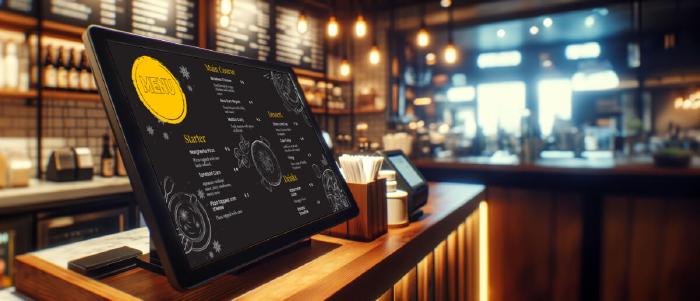
Dec 21 2023
8 min read

The age of digitalization has been transforming every sphere in the private and public sectors. Let’s say public places with heavy traffic, like healthcare centers, airports, railroad stations, supermarkets, and public libraries, are always buzzing with people looking for some or other information, and to their rescue came the manual information desks.
But, with the advent of digital signage, digital information kiosks have proved to be a boon with their innumerable advantages. With their vivid and vast multimedia content, the digital information kiosks provide users with a visually appealing and engaging medium. Also, real-time updates are a cakewalk with the help of digital signage technology
An informational kiosk is an interactive or non-interactive machine that delivers relevant and helpful information to people. The informational kiosks are user-friendly and convenient. Interactive information kiosks use a touchscreen where users can put in their queries and receive relevant answers, guidance, or suggestions. Some informational kiosks even have features for audio interactions
Information kiosks are self-sufficient devices that provide accessible information like maps, places of interest, food choices, payment options, flight or train schedules, product information, and more helpful content. These help the users to make informed decisions without any other human assistance.
The information kiosks can be placed outside in the open for public guidance, or there can be indoor information kiosks. The outdoor information kiosks are more robustly designed to withstand all sorts of weather and external tampering, if any. These are found in tourist places, transportation hubs, significant events in open spaces, etc. Indoor information kiosks are preferred by most industries as those can be designed as per the requirement and need not be as enormous as the outside information kiosks.
Information kiosks generally fall into three main categories: outdoor, indoor, and custom. Each type is designed to serve specific environments and user needs.
Outdoor kiosks are built to withstand harsh weather and challenging outdoor conditions. These kiosks are made from durable materials and feature weatherproof touchscreens with high brightness levels to ensure clear visibility even in direct sunlight. They are designed to endure various climatic conditions, with features like snow resistance, rainproofing, or heating and cooling systems to maintain functionality in extreme temperatures. Outdoor kiosks are typically larger and more robust than indoor versions, often found in transportation hubs, public parks, and on city streets. They are usually freestanding with a wide, sturdy base for enhanced durability.
Also read: Major mistakes to avoid while placing oudoor digital signage
Indoor kiosks are designed with a focus on aesthetics and user interaction. These kiosks are often interactive and can be found in high-visibility locations such as malls, hospitals, and airports. Smaller indoor kiosks are commonly used in retail stores or lobbies, while larger ones are favored in airports and shopping centers. They can be wall-mounted at different heights depending on the required user interaction, making them adaptable to various indoor settings.
As the name implies, custom kiosks can be tailored for both indoor and outdoor use, with customizable size, shape, and functionality. These kiosks are often equipped with unique software and hardware solutions, such as biometric scanners or card readers. Additionally, custom kiosks can be personalized with specific colors, logos, and themes to match a brand’s identity. They are particularly useful in specialized industries like healthcare, education, or retail. Using digital signage software like Pickcel, these kiosks can provide great customization options for design and layout, with numerous templates and integrations available.
Both indoor and outdoor kiosks can be equipped with extra privacy features, such as those used in ticketing or ATM kiosks. Moreover, kiosks are often designed with accessibility in mind, incorporating features like lower screen heights and accessible buttons to accommodate users with disabilities.
Also read: How kiosk digital signage is changing the customer experience
Since public spaces are primarily busy with people pacing up and down and always in a hurry, the information kiosks are relevant in solving many issues on the go. These provide quick and easy access to various information without waiting for anyone to assist the users. Let us take a look at the importance of information kiosks in public spaces:
1. Emergency notifications: In cases of emergencies, the information kiosks can rapidly spread the information to people gathered and alert them in possible ways. For example, in case of a fire in a shopping mall, the information kiosks placed in heavy traffic areas can alert the customers, show evacuation routes, explain safety measures, and keep them updated immediately.
Checkout: How to publish emergency alerts On digital signage using the Pickcel 'Quickplay' Feature

2. Enhanced user experience: The digital information kiosks are attractive, with vivid screens displaying various multimedia contents. These displays can be informative and entertaining for the people waiting in public spaces. Also, these screens use touchscreen interfaces to engage the users in an interactive exchange of information.
3. Reduced wait time: The information kiosks reduce unnecessary crowding and long queues outside customer care sections. The users can immediately respond to human assistance in busy public spaces. For example, in huge grocery stores, customers need to wait in long queues to get information on product availability or even billing.
Round-the-clock availability: Another relevance for information kiosks is that they can be at the user’s service round-the-clock. The kiosks enable users to access information even beyond the regular working hours of the employees. For example, when passengers have to take airport flights in the wee hours, there might not be enough staff available. But the information kiosks can help find ways to locate cafeterias or avail flight information to the boarding gates.
Know more: How interactive digital signage is transforming the offline marketing trends with 'user first' approach

The many advantages and huge relevance in public spaces are helping information kiosks gain popularity. These allow customers a certain amount of liberty when accessing information. Let us discuss the benefits that any business can have from installing information kiosks:
1. Cost and time efficient: Informational kiosks can replace or reduce human staff to a considerable number, hence resulting in cost savings. Not just cost, these kiosks can save time as well. Since customers can self-operate and access information, it saves time, and the staff can concentrate on more urgent work.
2. Customizable: Different users have different needs, and the information kiosks can customize information based on user preferences, choice of language, or any other demands and provide a tailor-made experience to them.
3. Reduced errors: Well, as Alexander Pope said, ’to err is to human…’ Installing digital information kiosks can reduce the chances of human errors. Kiosks are connected to databases, ensuring accurate and updated information is displayed. Also, standardized information is delivered by the information kiosks, reducing the errors that might happen through miscommunication among humans.
4. Connectivity: The information kiosks are well-connected to a network. These can be operated remotely from anywhere with a click. This allows the businesses a lot of flexibility and helps maintain consistency and makes real-time updates a cakewalk.
5. Data collection: Through touchscreen interfaces, digital information kiosks can collect data through interactive information exchange. This feedback and data collected can be analyzed and later used to provide better customer experiences, which will increase business revenue.
Check out: How amazon solved the product marketing challenge for amazon mall-kiosks with Pickcel
Information kiosks play a critical role across various industries, offering self-service options, enhancing customer experience, and streamlining operations. Below are the top industries where information kiosks are particularly vital:
1. Retail:
Information kiosks with interactive touchscreen significantly enhance the customer shopping experience, reduce staff workload, and boost sales through interactive promotions. They are commonly used for product information lookup, price checking, in-store navigation, self-checkout, and promotional displays.
2. Healthcare:
In the healthcare industry, information kiosks provide easy access to health information and educational content, reduce wait times, and improve patient flow. Common uses include patient check-in and registration, wayfinding within hospital premises, and appointment scheduling.
3. Transportation:
In the transportation industry, information kiosks streamline travel processes, reduce queues, and improve passenger experience. They assist with ticketing and check-in, provide real-time travel information, and offer wayfinding in airports, train stations, and bus terminals.
4. Hospitality:
The hospitality industry benefits from information and payment kiosks by offering self-check-in/check-out services at hotels, providing information on local attractions and events, and offering interactive maps for resort navigation. These kiosks enhance the guest experience by providing quick access to information, facilitating payments, and reducing wait times.
5. Education:
On educational campuses, kiosks facilitate smooth navigation and access to information, enriching the experience for students and visitors. They are used for campus wayfinding, event information, and information dissemination during conferences or open days.
6. Government:
Information kiosks increase efficiency in public service delivery and reduce queues in government offices. They serve multiple purposes, including providing service information, supporting self-service applications, offering voting and election information, and disseminating public information and announcements.
7. Banking and Financial Services:
In the banking and finance sector, information kiosks provide 24/7 access to services, reduce branch congestion, and enhance customer service. They are often used for self-service banking, bill payments, and displaying product information and promotions.
8. Corporate Environments:
In corporate settings, kiosks are used for employee check-in and visitor management, meeting room booking, corporate communication and announcements, interactive dashboards displaying company data, and wayfinding in large office complexes.
Here are a few use-cases discussed found in India and abroad, where information kiosks have served as a popular and beneficial device for customers as well as businesses.
1.Determine functionality needs: Assessing the primary purpose of the kiosk in your public space is of primary importance. Whether it’s for wayfinding, information dissemination, ticketing, or check-in services, choose a kiosk that offers the specific functionalities required to meet your objectives efficiently.
2.Consider user interface: Opt for kiosks with intuitive, user-friendly interfaces. Touchscreens should be responsive, and the software should be accessible for all users, including those with disabilities. Ease of navigation and the overall user experience in the design should be optimized for all users.
3.Evaluate durability and security: Since you’re installing kiosks in public spaces, ensure that they are built to withstand heavy use and varying weather conditions if placed outdoors. Security features should protect against vandalism and unauthorized access, ensuring user data is safeguarded.
4.Assess connectivity and integration: Ensure the kiosk can seamlessly integrate with your existing systems and databases. It should offer reliable connectivity options (Wi-Fi, Ethernet, etc.) for real-time updates and interactions, facilitating efficient operations and maintenance
Check out: Pickcel's interactive kiosk touch screen solution for all your business needs
Here are a few use-cases discussed found in India and abroad, where information kiosks have served as a popular and beneficial device for customers as well as businesses.
1. New York City Department of Transportation (NYC DOT): NYC DOT implemented digital information kiosks across the city to provide pedestrians with real-time transit information, maps, and updates on local events. These kiosks, called “LinkNYC,” also offer free Wi-Fi, phone charging, and emergency services contact information.
2. Changi Airport, Singapore: Airports have been long installing information kiosks for providing easy access to information to flyers regarding flight schedules, airport layout, wayfinding boarding gates and so on. Changi airport has automated kiosks for check-ins and baggage drop-offs. These screens even have infrared sensors which detect finger movements and you can receive desired information without touching the screen.

3. Kolkata Metro: The Kolkata Metro has taken an initiative to install digital information kiosks that will help people learn all about the Kolkata Metro and advertisers can use them for their business. This can help in earning revenues for the Kolkata Metro as well. These kiosks have been set up in a few prominent stations where the traffic is usually heavy. But gradually all the stations will have these digital standees installed.
4. City of Toronto: Toronto launched digital information kiosks known as “TO360” at various locations across the city to provide residents and tourists with interactive maps, points of interest, transit information, and local news updates.
5. Nehru Hospital, Chandigarh: This hospital in Chandigarh is way advanced and has installed interactive kiosks for diagnosis. These interactive kiosks are AI operated and display a virtual doctor who helps with the diagnosis. These kiosks can assist doctors and paramedics as well. The interactive kiosks can also save medical history in a QR code which saves tons of papers and can be easily shared with the concerned people.
Thus, from busy airports to museums to shopping complexes, information kiosks have gained immense popularity for their innumerable advantages. By embracing a smarter approach to information, these kiosks have guided their users through various difficulties and engaged them with valuable information.





Dec 21 2023
8 min read

Dec 19 2023
8 min read

Dec 14 2023
8 min read

Dec 8 2023
8 min read
Take complete control of what you show on your digital signage & how you show it.
Start Free Trial Schedule My Demo